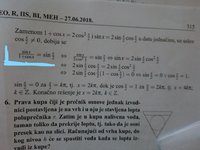dolina dahani
New member
- Joined
- Mar 22, 2020
- Messages
- 24
Guys I know this is elementary but im really confused when can i multiply the bottom? So i got a question about trig equation and im confused i got the same answer but im not sure if its right? I didnt multiply the bottom but left it and subtracted both sides by sin(x/2) and changed sinx to 2sinxcosx and crossed the square of cos and upper cos(x/2) and just left it as (sin(x/2)(1-cos(x/2))/cos(x/2) So to not confuse you here's their answer... Again my question is why did they do that if im not mistaken its best to not cross multiply???



